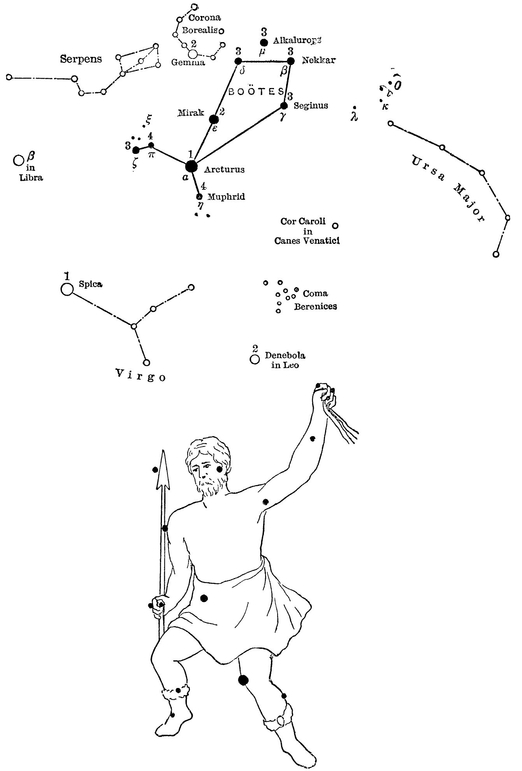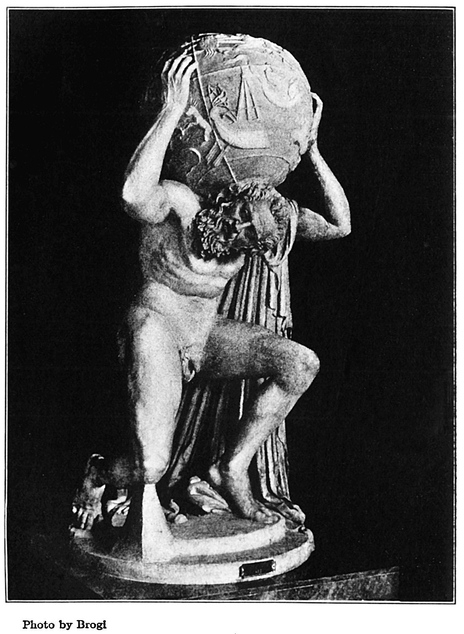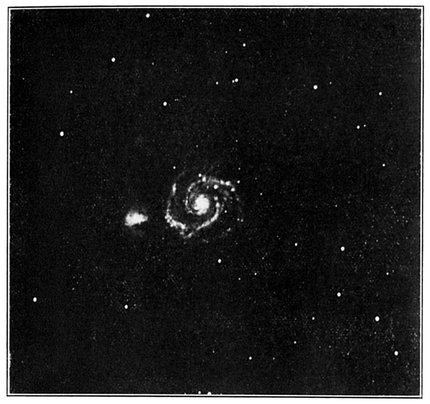Boötes
The Bear Driver

BOÖTES
BOÖTES
THE BEAR DRIVER
And next Boötes comes whose ordered beams
Present a figure driving on his teams.
MANILIUS.
THE original title of this constellation was in all probability “Arcturus,” the present title of the lucida of the constellation, a famous star of the first magnitude. The title Boötes, pronounced B -
-
 -t
-t z, appeared in the Odyssey , and according to Allen has been in use for at least three thousand years.
z, appeared in the Odyssey , and according to Allen has been in use for at least three thousand years.
The stars in this region of the sky seem to have attracted the admiration of almost all the eminent writers of antiquity. Aratos pays this tribute to Boötes:
Behind and seeming to urge on the Bear
Arctophylax, on earth Boötes, named
Sheds o’er the arctic car his silver light.
And eight hundred years later Claudian wrote:
Boötes with his wain the north unfolds.
Boötes is represented by the figure of a mighty man with uplifted hand, holding in leash two hunting dogs. He seems to be pursuing the Great Bear around the Pole, and hence Boötes is often referred to as “the Bear Driver.”
Carlyle in Sartor Resartus thus mentions the constellation : “What thinks Boötes of them as he leads his Hunting Dogs over the zenith in their leash of sidereal fire?”
Boötes is also represented as a Herdsman and a Ploughman, guiding the Wain, as the constellation Ursa Major is sometimes called. Cicero takes this view, and adds that Boötes was sometimes called “Arctophylax” from two Greek words signifying “bear keeper” or “bear driver.”
The name Boötes, according to some authorities, is derived from the Greek βους, meaning ox, and  θε
θε ν, to drive. Others claim that the title was derived from βoητ
ν, to drive. Others claim that the title was derived from βoητ ς, meaning clamorous, descriptive of the shouts of the driver, or the call of encouragement to the hounds, hence the constellation has been sometimes called “Vociferator” and “Clamator.”
ς, meaning clamorous, descriptive of the shouts of the driver, or the call of encouragement to the hounds, hence the constellation has been sometimes called “Vociferator” and “Clamator.”
The mythology of the constellation is interesting. According to some of the Greeks it represented Icarius the father of Origone, others claim it represented Erichthonius, the inventor of the chariot. It was also said to be Areas, the son of Zeus and the nymph Callisto.
Plunket claims the date 6000 B.C. and latitude 45 degrees north, for the time and place of the invention of this constellation, as then and there Boötes might be seen at midnight of the summer solstice standing upright on the northern horizon, his head reaching nearly to the Pole. Never since that date has he held so commanding a position in the sky, nor at any more southern latitude could his whole figure have been represented as standing on the horizon.
Boötes has also been called “Atlas” from its nearness to the Pole, and because it appeared to hold up the heavens. In all probability Boötes has been deprived of an arm, the stars formerly representing it now forming the constellation of the Northern Crown. Proctor thinks that this change was made at some time preceding that of Eudoxus, who was born about 300 B.C.
The risings and settings of Boötes which took place near the equinoxes portended great tempests. Boötes sets in a perpendicular position, and takes eight hours to make his exit, hence allusions to his sluggish and tardy movements are found in the works of the ancients. Manilius thus refers to this peculiarity of the Herdsman:
Slow Boötes drives his ling’ring teams.

Atlas
National Museum, Naples

Spiral Nebula in Canes Venatici
And Aratos describes him as:
When tired of day
At even lingers more than half the night.
Boötes is an early riser so to speak, making up for his late hours, as he rises horizontally, “all at once,” as Aratos wrote.
According to Allen the early Catholics knew Boötes as St. Sylvester. Cæsius said it might represent the prophet Amos, the Herdsman or Shepherd, and Dr. Seiss thought it represented the Great Shepherd and Harvester of Souls.
The shepherd idea as connected with Boötes is borne out by its proximity to the Pole, which the Arabs regarded as a sheepfold, and Boötes has accordingly been called “Pastor” by some, meaning Shepherd. This title conforms to the title “Sibzianna” for the constellation, which appears on the ancient Euphratean star list, and which means “Shepherd of the Life of Heaven.”
Burritt informs us that the ancient Greeks called this constellation “Lycaon,” a name derived from λuχoς which signifies “a wolf.” The Hebrews called Boötes “Caleb Anubach,” meaning “the Barking Dog,” while the Latins among other names called it “Canis.”
This allusion to a barking dog and a wolf in connection with Boötes seems to refer again to the Arabs’ polar sheepfold. Their imaginary picture contained a flock of sheep, a shepherd and his dog, and a wolf or hyena lurking near by in search of prey.
“Seginus,” “Nekkar,” and “Alkalurops” are names that have also been applied to this constellation, but now they appear as individual star names.
Boötes also figures as a spear or lance bearer, the shepherd’s staff which he was represented as bearing having been changed into a more formidable weapon.
In Burritt’s Atlas Boötes appears with his back turned to the bear which his hounds are closely following, and his attitude is anything but one of pursuit.
Landseer and Lalande both held that the Bear Driver was the national sign of ancient Egypt, the myth of the dismemberment of Osiris originating in the successive settings of its stars, and that there it was called “Osiris,” “Bacchus,” or “Sabazius,” the ancient name for Bacchus and Noah.
The star Alpha Boötis bears the name “Arcturus.” This glorious star has excited the admiration of all mankind, and from the earliest times we find it mentioned. Without doubt it was one of the first stars to be named. Arcturus is one of the few stars alluded to in the Bible, where we find a reference to it in the Book of Job, hence it is sometimes called “Job’s star.”
Arcturus probably owes its name to its proximity to Ursa Major, as it means “the watcher of the Bear.” The name of this star according to Gore is derived from the Greek words  ρ
ρ τος and o
τος and o ρ
ρ , which signify a bear’s tail, so called because it lies nearly in the continuation of the Great Bear’s tail.
, which signify a bear’s tail, so called because it lies nearly in the continuation of the Great Bear’s tail.
Virgil frequently mentions Arcturus, and Manilius in his reference to Boötes thus speaks of its position in relation to the figure of the Herdsman:
Below his girdle, near his knees, he bears
The bright Arcturus, fairest of the stars.
In early days Arcturus represented a spear in the hunter’s hand, and with the Arabs it was “the Lance Bearer.” Emerson, in his translation of the Persian poet Hafiz, wrote:
Poises Arcturus aloft morning and evening his spear.
Like many other prominent stars Arcturus shared its name with the constellation. Miss Clerke is of the opinion that Arcturus received its name long before the constellation was thought of, forming the nucleus of a subsequently formed group.
Allen states that this star was famous with the seamen of early days even from the traditional period of the Arcadian Evander, and regulated the annual festival by its movements in relation to the sun.
Mrs. Martin thus paints a scene of springtime to which Arcturus lends its lustre: “What more gracious day’s progress in beauty could there be than to travel with the eyes from the cheerful hepaticas dotting the soft ground among the trees to the round, white, silent blossoms of the dogwood fringing the late April woods, and thence, when the evening falls, to the bright yet gentle light of Arcturus in the sky, announcing the end of the purple twilight.”
The Chinese designated Arcturus “the palace of the Emperors.” They also called it “Ta Ki ,” meaning the “Great Horn,” four small stars near by being “Kang Che,” the “Drought Lake.”
,” meaning the “Great Horn,” four small stars near by being “Kang Che,” the “Drought Lake.”
The Eskimos called Arcturus “Sibwudli,” and it is the timepiece of the seal netters during the great night fishing in December and January. The position of this brilliant star as it circles round the Pole enables them to judge how the night is passing.
The Arab name for Arcturus was “Al-sím k-al-R
k-al-R mih,” meaning “the simak armed with a lance,” also translated “the leg of the Lance-Bearer,” and “the lofty Lance-Bearer.” Gore states that according to the Persian astronomer Al-Sufi, who wrote a description of the heavens in the 10th century, the word simak means “elevated,” referring to the high altitude the star attains above the horizon. Schjellerup however, thinks that the word refers to the brilliancy of the star and not to its altitude. The Arabs also knew Arcturus as “the Keeper of Heaven.”
mih,” meaning “the simak armed with a lance,” also translated “the leg of the Lance-Bearer,” and “the lofty Lance-Bearer.” Gore states that according to the Persian astronomer Al-Sufi, who wrote a description of the heavens in the 10th century, the word simak means “elevated,” referring to the high altitude the star attains above the horizon. Schjellerup however, thinks that the word refers to the brilliancy of the star and not to its altitude. The Arabs also knew Arcturus as “the Keeper of Heaven.”
In India, Arcturus marked the 13th lunar station, known as “the Good Goer” or perhaps “sword,” but figured as a coral bead, gem, or pearl. It was also known in India as “the outcast.” As might be expected of so conspicuous a star, we find many of the Egyptian temples oriented to it.
Al-Biruni mentioned Arcturus as “the Second Calf of the Lion,” the star Spica representing the First Calf. Allen states that this star has been identified with the Chaldeans’ “Papsukal,” the “Guardian Messenger,” while according to Smith and Sayce, Arcturus was “the Shepherd of the Heavenly Flock,” or “the Shepherd of the Life of Heaven,” undoubtedly the Sib-zianna of the inscriptions. Strange to say the Eskimo title for the star, Sibwudli, has the same first syllable as the title of the Euphratean hieroglyphics.
Arcturus was long supposed by the ancients to be the nearest star to the earth. Its influence was always dreaded, as the writings of Aratos and Pliny testify, and its rising and setting were supposed to portend great tempests.
Hippocrates, who lived about 460 B.C., made much, says Allen of the influence of Arcturus on the human body, in one instance claiming that a dry season after its rising agrees best with those who are naturally phlegmatic, and that diseases are especially apt to prove critical in these days.
Astrologically those born under Arcturus were destined to have honour and riches conferred on them.
Arcturus is a remarkable star by reason of its rapid motion through space, indeed it may rightly be called “a runaway star.” Since the days of Ptolemy it has moved over a distance equal to fully twice the moon’s apparent diameter, and even to the naked eye it no longer fits the alignment with other stars which Ptolemy described. Its proper motion in miles per second is given by different authorities as anywhere from one hundred to three hundred miles.
There is also great discrepancy in the estimate of the brightness of Arcturus as compared with the sun. Prof. Russell claims that Arcturus exceeds our sun in brilliance one hundred and fifty times, while some make Arcturus equal in illuminating power to six thousand such suns as ours.
According to Mrs. Martin it takes the light of Arcturus more than one hundred years to reach us. Serviss puts this estimate at forty or fifty years, and states that Arcturus is relatively an aged sun surrounded with a blanket of absorbing metallic vapours, which cut off a large part of his radiant energy, and gives to him a ruddy, fiery hue, especially when he is seen just rising from the horizon. At this time the scintillating colours of Arcturus as viewed in a telescope are beautiful to behold.
It has been proved that we do not receive from Arcturus more heat than we should from a candle at a distance of five or six miles.
Many who were fortunate enough to witness Donati’s great comet of 1858 will recall that at one time that comet’s head almost occulted Arcturus, and yet its splendour was undiminished.
Prof. Nichols’s account of this wonderful sight is worth quoting in this connection:
“It was a spectacle the like of which no one might see again though he should spend on earth fifty lives. At the beginning the comet was like a plume of fire, shaped like a bird of paradise, but it soon brightened into a stupendous scimitar, brandished in the sunset, and when it swept over Arcturus the whole astronomical world was watching to see what would happen to the star.”
Arcturus comes to the meridian on June 8th at 9 P.M.
Whitman wrote the following beautiful poem to Arcturus :
Star of resplendent front: thy glorious eye
Shines on me still from out yon clouded sky,
Shines on me through the horrors of a night
More drear than ever fell o’er day so bright,
Shines till the envious Serpent slinks away
And pales and trembles at thy steadfast ray.
Hast thou not stooped from Heaven fair star, to be
So near me in this hour of agony ?
So near, so bright, so glorious that I seem
To lie entranced as in some wondrous dream,
All earthly joys forgot, all earthly fears
Purged in the light of thy resplendent sphere,
Kindling within my soul a pure desire
To blend with those its incandescent fire,
To lose my very life in thine, to be
Soul of my soul through all eternity.
The stars β, ϒ, δ and μ form a trapezium. This figure was known to the Arabs as “the Female Wolves.” They also called the star ε Boötis, “Izar” or “Mizar,” meaning girdle or waist cloth. This is a double star and its exquisite beauty has earned for it the name “ Pulcherima,” a title bestowed on it by the elder Struve. The two stars can be seen in a small telescope as the components are 3” apart.